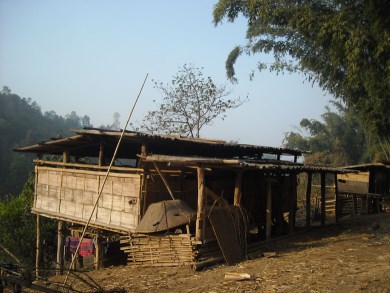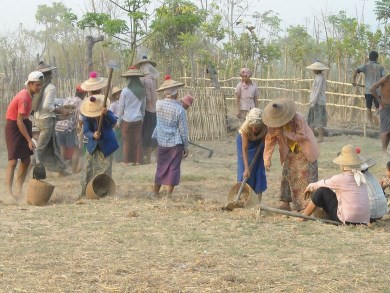
A hiding site of displaced villagers who had previously fled from their homes in Papun District. (Photo: KHRG)
The Border Consortium (TBC) has been collaborating with ethnic CBOs to document internal displacement and human rights violations in eastern Burma since 2002. In an October 2008 report, TBC (2008) documented the forced displacement of 142 villages and hiding sites, as well as an estimated 66,000 people who were forced to leave their homes as a result of, or in order to avoid, armed conflict and human rights abuses during the year before data collection. All in all, TBC has documented the destruction, forced relocation or abandonment of more than 3,700 villages in southeast Burma since 1996 (TBC, 2012c). Their newest findings about internal displacement suggest that no further villages in southeast Burma were destroyed between August 2011 and July 2012, and although over 10,000 people were forced to leave their homes during the year before data collection, this represented a significant decrease of the average 75,000 people displaced every year since 2003 (TBC, 2012c). An estimated 400,000 people remained displaced in rural areas across 36 townships in southeast Burma in late 2012 (TBC, 2012c). This figure was not updated in 2013. Ongoing militarisation and concerns about protection and security have thwarted efforts to prepare for resettlement of the displaced (TBC, 2014a).
In 2004, Karen Women’s Organisation (KWO) published a report which documented 125 cases of systematised rape and sexual abuse of women in Karen State, crimes which were committed by the Burmese military over a period of twenty years (KWO, 2004). It was followed by a second report in 2007, which documented over 4,000 cases of different human rights violations including the ongoing rape, murder, torture and forced labour suffered by women in the Karen State, all perpetrated by the Burmese army. In 2010, KWO published a third volume of evidence, focusing on the persecution suffered by Karen women village chiefs. KWO (2010) documented nearly 100 cases of the persecution of women village chiefs from 1982 until 2009, including crucifixion, people burnt alive and beaten to death, arbitrary executions, gang rape, many forms of torture, and slave labour.
In a comprehensive human rights report covering the period from November 2010 to December 2011, Karen Human Rights Group (KHRG) (KHRG, 2011) documented the occurrence of 17 categories of human rights abuses faced by villagers in Karen State, Mon State, Pegu Region, and Tenasserim Region in eastern Burma. Human rights abuses faced by rural ethnic communities were consistent with patterns KHRG has documented since 1992, including sexual violence, forced minesweeping, and summary executions. KHRG published another short report in May 2012 (KHRG, 2012b), documenting ongoing violent abuse, arbitrary detention, and forced labour in the Karen State even after Karen National Liberation Army (KNLA) and 5th Brigade of Democratic Karen Buddhist Army (DKBA) had signed ceasefires with the government. Villagers reported that abuses were committed by both Burmese military and the DKBA. In its latest report covering the period since the 2012 ceasefire, KHRG (2014a) found that civilians were still arbitrarily arrested, detained, violently abused, tortured, and/or killed in all Karen districts.
Physicians for Human Rights (PHR) has been investigating human rights abuses against Burmese civilians, dissidents, minorities, and refugees since 2004. In early 2012, PHR conducted a study in the Karen State with a sampling frame of about 80,000 people in 250 villages across the state (Davis, Gittleman, Sollom, Richards & Beyrer, 2012). PHR’s research shows that during 2011, as citizens in Rangoon experienced new freedoms, nearly one third of the 665 households surveyed in the Karen State reported a human rights violation. Forced labour was the most common form of abuse with 26% of households reporting some kind of forced labour in the past year, including being porters for the military, growing crops, and sweeping for landmines. PHR’s research also indicated that 17.4% of households in the Karen State reported moderate or severe household hunger.
In Kachin State, many reports have documented severe violations ever since the armed conflict resumed in June 2011. November 2011 reports by Partners Relief and Development (2011) as well as PHR (Davis, 2011) both documented serious human rights violations committed by the Burma Army soldiers in the Kachin State. A more recent report by Human Rights Watch (2012c) found a similar patterns of abuse; the Burmese army used men, women, and children as porters in the front lines, deliberately attacked ethnic Kachin villages and killed civilians, engaged in torture and other ill-treatment of detainees, committed rape and other forms of sexual violence, and looted and razed homes and other civilian property. Child soldiers were conscripted into the Burmese army, and both the Burmese army and KIA (to a lesser degree) used antipersonnel landmines that caused dozens of deaths and serious injuries. According to Human Rights Watch (2012c), the Burmese government has not seriously investigated allegations of abuse in the state or taken action to prevent further abuse. Kachin Women’s Association Thailand (KWAT) reports from 2013 (KWAT 2013a, 2013b) suggest that serious violations continue in the state, with government forces torching villages and IDP shelters, and killing, torturing, and raping villagers. Fortify Rights’ recent report found the systematic use of torture by Burmese authorities against Kachin civilians in Kachin State and northern Shan State from June 2011 to April 2014 (Fortify Rights, 2014a).
The US State Department (2014) reported that although the government’s reform efforts have resulted in human rights improvements, significant human rights problems persisted throughout the year 2013, including conflict-related abuses in ethnic border states, politically motivated arrests, widespread societal discrimination and violence against Muslim populations, and a general lack of rule of law resulting in corruption and widespread land confiscation. Government security forces allegedly were responsible for cases of extrajudicial killings, rape, and torture, and prison conditions were harsh and life threatening. Recruitment and use of child soldiers continued, and forced labour and human trafficking persisted. Political prisoners who were freed experienced significant restrictions following their release. The government continued to restrict freedom of speech, press, assembly, association, religion, and movement.

Villagers engaging in forced labour, repairing a Burma army-controlled vehicle road in 2009. (Photo: KHRG)
ND-Burma, comprising of 12 member organisations representing different groups in Burma, has published a number of reports (2012a, 2012b, 2012c, 2013a, 2013b, 2014a) documenting the Burmese government’s mistreatment and abuse of its own people since the 2010 elections.
From January to December 2011, ND-Burma’s member organisations documented 371 cases of human rights violations across the country (ND-Burma, 2012a). They found that 22% of the cases constituted torture and ill treatment, which were found to take place in two distinct places in Burma; in detention centres where political prisoners are interrogated and held, and in ethnic nationality areas where the Burmese military is present. In ethnic areas, torture commonly took place in military bases or in remote rural villages. Other human rights violations included arbitrary arrest, forced labour, forced portering, confiscation of property, restriction of movement, and sexual violence. Shan, Kachin, and Karen States were particularly hard hit. Over the period of April to September 2012, ND-Burma documented 114 cases of human rights violations, of which 27 cases were forced labour, 26 land confiscation, and 21 torture (ND-Burma, 2012c). ND-Burma’s 2013 reports found an ongoing pattern of abuse by the Burmese military in both active conflict and ceasefire areas (2013a, 2013b). Findings gathered in 2013 found altogether 210 human rights violations, of which 71 were cases of destruction or confiscation of property, 34 torture, 23 arbitrary taxation, and 22 killings (ND-Burma, 2014a, 2014b). ND-Burma also noted that documentation from conflict areas is likely not reflective of the severity of the situation, due to the security challenges faced in those areas.
On the whole, data collected after the 2010 elections serves as a reminder to the Burmese government and the international community that significant hurdles remain for Burma to emerge as a functioning democracy. There is a long way to go until the Rule of Law and the rights of the people of Burma, particularly ethnic nationalities, are respected.
Updated October 27, 2014
Continue to Patterns of State Abuse
